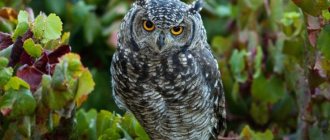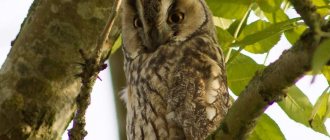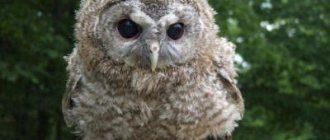The benefits of the lifestyle of owls and larks are an eternal subject of debate and doubt among both specialists and ordinary people. Many find it extremely difficult to deal with their biorhythms, and often life requires quite a serious reshaping of them, for example, for work.
“Each of us considers himself to be one or another category of people. Some people get up early all their lives, while others are used to sleeping until lunchtime. We can safely say that different biorhythms radically affect lifestyle, character and well-being. Experts who study this area are talking about this more and more. Many of them have already agreed that being a lark, that is, getting up early, is healthier for the body. This way, a person does not disturb the established biorhythm: sleep at night and stay awake during the day. And if larks do have an advantage over owls, can owls be retrained? Is it necessary to do this? - says Elvira Tarasova, consultant somnologist .
What sound does an owl make?
List of animal sounds
| Animal | Description | Sound |
| mosquito | squeak, buzz | The sound of a flying mosquito |
| mouse | squeak | |
| okapi | cough, bellow | |
| owl | hoot | Menu 0:00 Owl hoot |
Interesting materials:
What to do if there is no rosin How to solder? What to do if Knox is stuck at 99? What to do if the laptop freezes and won’t turn off? What to do if the laptop does not respond to commands? What to do if the laptop does not see the Wi-Fi network? What to do if the laptop does not turn off completely? What to do if your new shoes feel too tight in your toes? What to do if your new sneakers are too tight? What to do if the shoes are big in the heel? What to do if your shoes are too small?
How an owl screams
Wanting to convey the atmosphere of a dense forest, writers and directors usually use the image of an owl or eagle owl as the most typical forest bird, the symbolism of which has long been characterized by witchcraft features. Although there is still a certain difference between these owls, usually their artistic image as the night lords of the forest is conveyed through their characteristic hoot. In fact, there is a wider range of sounds that give an idea of how an owl calls.
The unique polyphony of eagle owls
A loud hooting is most typical for the scarecrow, whose menacing and drawn-out hooting call can be heard at a distance of 2 to 4 km from the location of the bird itself. But it is not for nothing that the eagle owl has become popular among the people as a witchcraft bird, plying on the border between worlds.
He can give way to hysterical laughter, which then turns into coughing, and then into lingering moans and even crying. How can you not believe that a werewolf was hiding in the forest after hearing an owl scream?! It was for this eerie polyphony that the common eagle owl was nicknamed the scarecrow.
But the Nepalese eagle owl makes even more frightening screams. Its eerie vocalization, similar to human muttering, has long endowed this bird with a mystical aura with an unpleasant reputation. These beautiful representatives of owls were so feared that, if possible, they tried to destroy them by throwing stones at them. The result is sad - the population of these eagle owls is very small.
In general, eagle owls are one of the most talkative members of the owl family. They are especially “talkative” during the mating season, when they often create “vocal” duets with females.
For example, great eagle owls may make loud squeals and a series of buzzing and coughing sounds at this time. With muffled shouts, they notify their rivals that the territory is occupied by them and they should not lay claim to it.
If something scares the eagle owls, they can notify the surrounding area by emitting something like a dull dog bark. When threatened, eagle owls usually emit an angry hiss or whistling scream.
How does a long-eared owl call?
Representatives of the owls themselves, although less “talkative” than eagle owls, are also distinguished by a rich variety of vocalizations. The long-eared owl, which is often called the “little eagle owl,” is famous for its interesting polyphony, for the similarity in the presence of feather “ears” and the variety of sounds it makes.
In the spring, males attract females with a monotonous melancholic “serenade” of hooting calls, which they repeat many times every 1.5-3 seconds. The response of the females in this owl duet sounds like a hoarse, repeated “heh-heh.”
When attacking an enemy who approaches the habitat of the long-eared owl, these birds emit a sharp “kwik-kwik” or menacing hooting. During the first period of their independent life, the chicks of these owls deafen the area with their whistling whistling.
How do other species of owls call?
“Queens of the Arctic” - white owls - are one of the most silent birds in the owl family. They exhibit vocalization exclusively during the mating season, emitting squealing calling trills - “serenades”. Occasionally, polar owls can deafen the area with barking and croaking sounds.
Short-eared owls are especially curious. Their chicks are capable of emitting very loud calling calls even a week before hatching from the egg.
Adults are not particularly talkative. They are most characterized by yelping and crackling sounds. In case of danger to their home, they can distract enemies with loud screeching.
Hawk owls use gurgling sounds to attract females, which can be heard at a distance of 1 km. But between the calls they make, lasting up to 10 seconds, there are usually long breaks.
Spine-footed owls produce frequent but short hooting calls (up to 50 times per minute). They are talkative not only during the period of searching for a “soulmate.” Female neotropical owls attract their mates with loud calls, similar to a locomotive whistle.
How do tawny owls and screech owls call?
The “love serenades” of great gray owls are similar to the sounds that long-eared owls make. Gray owls are distinguished by their melodious hoots, while long-tailed owls imitate a dog's bark and hum protractedly.
In general, talkativeness is not typical for representatives of this family. These are rather silent owls that do not exhibit increased vocalization even during the mating season.
Owls are famous for their curious sounds. The most melodic among them are Scops Owls, which emit the drawn-out calls of “tyu-yuyu” and “spit-yu”, which gave them their specific name.
The sounds made by the owl are most reminiscent of the cooing of pigeons. Collared owls are not particularly famous for their eloquence. They attract females with “cluck-cluck” calls.
The most sociable in this family of owls are considered to be eastern cutworms. They use quiet whistling to “communicate” with each other. When danger arises, these cutworms make purring sounds. Melodic trills, like the sound of a flute, are characteristic of the most beautiful owls - white-faced owls, which are famous for their real concerts “in the name of love”.
How does an owl scream?
The vocalizations of representatives of the owl genus are also impressive with an interesting range of sound capabilities. Almost all birds of this species are distinguished by increased talkativeness.
But with a wide variety of vocalizations, hissing sounds are most characteristic of owls, for which they received their specific name, according to one version, derived from the word “hiss.”
But each variety of these owls also has its own specific “vocal” characteristics. So, Brahmin's owls attract females with calls, like gnashing.
Sparrow owls are famous for their twilight “trills” that can last continuously for an hour or more. In general, their cry most closely resembles the chirping sounds of sparrows, differing from them in whistling calls and whispering. Such sounds are very loud and can be heard for several kilometers around the area.
Rabbit owls are known as the most unique bird mimics. They can emit a hiss, which is characteristic of rattlesnakes, and thereby scare away uninvited guests from their homes. Miniature elf owls lure their lifelong mates into their nests with short “wee-wee” calls.
The most beautiful mating “serenades” among the owl family are produced by the tiger-footed owl. Its sounds are similar to the quiet but rhythmic sound of a flute. But to scare away enemies, these birds use sharp screams with a characteristic whistle.
The most talkative is the little owl, impressive with its extensive vocalizations. To attract females, he uses loud nasal calls, issued one after another after 5 minutes.
At other times, little owls can imitate meowing and yapping, and also make whistling and hooting sounds. They are especially talkative in the rain.
How do barn owls call?
Barn owls have a wide range of sounds, but are not particularly talkative. To “communicate” with each other, they can also use simple clicking of their beaks. But these birds also make wheezing and hoarse hooting sounds, which gave them their specific name.
Representatives of the Ceylon masked barn owls exchange loud whistles and calls among themselves. But the most original sound is the cry of the black barn owl, which makes chirping, crackling and the most characteristic whistle, like a falling bomb.
Retraining methods
1. Each person can independently determine for himself the number of hours during which he gets enough sleep.
2. It is worth moving things and work from the evening to the first half of the day in order to fall asleep early. Stop watching TV, using a computer, smartphone and other gadgets.
3. Before going to bed, be sure to ventilate the room.
4. Take a bath with scented candles or sticks, or an herbal bath. Ideally, you should book a relaxing massage. Meditation will also not hurt in adjusting your biorhythm.
5. A contrast shower in the morning will give you vigor and activity. A light breakfast is recommended.
6. Avoid caffeinated drinks and energy drinks during the day.
Sleep well. What is sleep hygiene? More details
What are owl eyes?
Due to the fact that owls have truly huge eyes, it was previously believed that they could see even in pitch darkness. This is partly true, but only partly.
In the twilight of the night, owls really see much better than people and the bulk of daytime birds of prey.
As experiments have shown, an owl's vision, like a cat's, also has its limits, and in complete darkness it is completely unable to see anything.
For a long time there was also a hypothesis according to which the eyes of an owl are a kind of device capable of perceiving heat rays. Allegedly, thanks to this “thermal imager,” the owl sees a warm mouse body that stands out against the general cold background of the earth. However, after special experiments were carried out, this theory was shattered to smithereens. Moreover, the same experiments showed that owls are not only unable to see warm, infrared radiation, but are not even able to perceive the color red.
It has always been believed that owls hunt at night only using their eyesight.
For example, when a captured owl was placed in a dark room, not only did it not see the mouse placed there, but it could not even “detect” it when it was illuminated with red light. However, as soon as the mouse moved or squeaked, the owl immediately rushed at it.
Owl on the hunt
The great owl stalks its prey with amazing patience, often for many hours. During this time, she sits somewhere low from the ground, frozen like a pillar. The bird's eyes are narrowed and it may seem that it is dozing, but it sees everything. The slightest rustle, and the tawny owl, without any sudden movements, easily turns its head in the direction of the sound source. And although her eyes are still closed, her ears are tense to the limit. They allow the nocturnal predator to determine the location of a potential prey.
When the ear determines the place where the seductive noise is coming from, the tawny owl opens its huge dark eyes wide. At this moment, her victim can be considered already doomed. After a short time, the tawny owl is already flying to its nest with prey in its paws, emitting a dull uterine “uh-huh.” This bird is indeed a very effective hunter. In just one season, the tawny owl catches about a thousand voles, which destroy crops and damage grain warehouses.
Owls do not look out for their victims, they listen to them.











